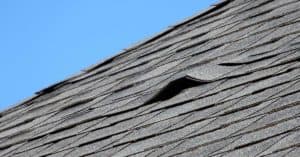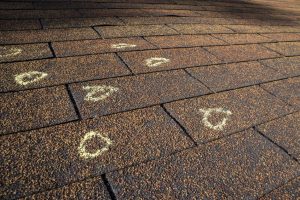The last thing you want to do is replace your roof too early, but at the same time, nobody wants to wait until it’s too late either. Knowing that your roof has been damaged and just when to change your roof can be difficult. As a homeowner I’ve dealt with multiple roof replacements. It’s a good thing I’ve had helpful friends around in the early years. From my experience, it’s mostly guesswork if you don’t know what you are looking for. For exactly this reason, I wanted to share with you 10 signs to know that your roof is damaged and may need to be replaced.
10 Signs Your Roof Needs to be Replaced
How Do I Know If My Roof Needs to be Replaced? Here are 10 Signs to help you out.
- Your Roof is Old Resulting in Warping
- Roof Leaks
- Broken Shingles
- Cracked and Broken Flashings
- Peeling Paint
- Damaged Vents
- Hail or Ice Damage
- Ceiling Stains
- Rusted Gutters
- Molding
It’s important to keep an eye on your roof. A damaged roof can let water or other element in to your house that could cause thousands of dollars in damage. Here are 11 signs of roof damage that should be dealt with to protect the inside of your home.

Damaged Shingle Roof with Curled Shingles
1. Your Roof is Old and Warping
Estimating how old a roof is can be very difficult. The easiest way to know the age of your roof is to check on documentation from previous replacements, but that isn’t always possible to do.
Sometimes looks can be deceiving when it comes to old roofing. Even if things look normal to the naked eye, it’s a good idea to have a local roofing contractor or home inspector come out and do a proper inspection of the roof. Underlying issues could be hidden by the shingles that you would have otherwise looked over. If these problems are ignored, it could be a lot more painful to fix later on down the road. Age is a very real and important factor to consider when looking into a roof replacement.
2 Your Roof Leaks
While water is most certainly able to enter your home through many different avenues, one of the most prominent signs of roof damage is leaks. Even the tiniest and insignificant leaks can end up costing you a lot of money if it is not taken seriously early enough. Mold, rotting, and more leaks are just a few of the terrible repercussions of not handling leaks soon enough. It’s important to ask “why is my roof leaking?“If you aren’t sure if you have leaks, a good place to check first is the attic. Leaks tend to always originate in the highest portions of your home.
3. You have Damaged Shingles
Another sure sign that your roof might need replacing is that your shingles are damaged, misshapen or missing. The damage to your shingles can happen over a long period of time in a variety of different ways. If shingles are broken or cracked, they can’t do their job and get rid of the water efficiently. This undoubtedly leads to moisture damage.
If the edges of the shingles are curving upwards or have a bubble-like center, this means that the shingles are more wind-vulnerable and aren’t as durable as they used to be. Shingles that aren’t installed correctly in the first place rip off during intense weather, leaving you with a lot of misaligned and missing shingles that can cause your roof not to ventilate the way it was intended to.
4. You have Damaged Flashings
If you have any flashing installed around the details, chimneys, valleys, skylights, rakes or walls of your home, separation can be a potential problem and a good sign that your roof needs replacing. If the flashing opens and closes due to contractions or expansions, the bottom part of the flange will actually lift up and cause water to enter your home. This means there can be sneaky leaks, and you don’t even know about it until it’s too late.
If you do happen to notice some of the signs that your flashing may be damaged, the best thing to do is to call your local roofing company to get a proper assessment on how extensive the damage actually is.

asphalt shingles roof damaged that is in need of repair.
5. You See Peeling Paint
Without proper ventilation, your attic can actually capture moisture towards the roofline. The moisture that’s captured can make the outdoor paint start to blister and peel.
If this is something that has started to happen around your home, this could also be a sign the system for your gutter is failing and needs to be replaced as well.
6. Damaged Vents
If the housings on your plastic or metal roof vents are cracked, it might be about time for a roof replacement. If you try a quick fix, it won’t be long-lasting and you will eventually be left with the same exact problem all over again. The only solution is to actually replace the entire vent.
Something else to look for is the type of nail that you used in the past. If you try to replace it on your own, switch out the metal nails for screws with rubber washers.
7. Hail or Ice Damage causes Leaks
Asphalt Roofing Hail Damage
Tiny pieces of hail won’t cause that much roof damage, but when hail gets to be the size of golf balls and baseballs, it can cause some serious damage to your roof. If you are looking for hail damage on your roof, one of the clearest things you can spot are dents in the flashing that surrounds the border of your roof. Some other things to look for with asphalt hail damage are:
- Asphalt shingles that are cracked
- Shingles that have bruising or are damaged
- Asphalt material that has pitted spots

Insurance Adjusters will mark hail damage on a roof to show the damage.
Ice is probably not something you have to worry about this summer, but the damage from previous snowstorms definitely is. A kind of ice dam is created when the snow that has collected on your roof finally melts.
When this happens, the liquid from the snow goes down to the eaves and then will actually refreeze again. If this happens enough times, ice is basically being squeezed underneath the shingles of your roof. Once it has frozen yet again, the cycle it follows means that it will melt, leaving you with nasty leaks in your home to deal with.
This kind of “ice damming” however is able to be stopped if the roofing system is ventilated the correct way. If this is a big concern, you should have your roof inspected for this as soon as possible.
8. Ceiling Stains
If you can see stains on your ceiling or walls, you are most likely having leaky roof problems. While it is relatively easy to actually fix the leak itself, it is much more difficult to track down the cause of the leak.
Even if you have scheduled a roof replacement, it is a good idea to try your best to prepare the leak. Even if it is a small leak, the damage that it can cause is exponential if it is not addressed. Sheathing, rotted framing, and mold is just a few of the problems you will encounter if leaks aren’t fixed quickly.
9. Rusted Gutters
Rust inside your gutters can actually cause a lot of leaking problems because of how they expand and contract. Rust problems can arise in every season, but especially after the winter months. In the winter, the really cold temperatures will cause a lot of ice to accumulate. This accumulation of ice will eventually cause your seams to be compromised. If this happens continually, this consistency of freezing temperatures can cause ice dams which cause gutter blockage in the long run. If the weather is a lot warmer where you are, the regular rainfall that happens in the winter leads to water accumulation, rust, and overflow.
10. Mold Damage
If your gutter system was installed a while ago, it most likely is separated into pieces that are segmented. If they were installed this way, they don’t really have the right kind of ventilation to keep dry in between the rainstorms which ultimately leads to mold problems.
There are sometimes some seams where the different pieces of the metal cover each other. This creates gaps that can contain moisture that is hidden from the air. If this is the case, it is a great place for mold to grow freely.
All of the seams and screws are concealing multiple places that house the water with no way for it to escape. Mold will originate there and will expand into other places from that point. From there, the mold is able to spread out and cause your roof to rot. You really want to try and get seamless gutters to avoid this problem.
Common Roof Damage Types:
Metal Roofing
If you have a metal roof on your home, you might think that your roof will be immune to hail damage, but this is not the case. Thankfully, if you have metal roofing, it’s quite easy to spot the damages. If you are looking for signs of damage, you will most likely see large, medium or small dents in the surface of the metal after a really bad storm with lots of hail. If these small dents are ignored, it could cause you some issues in the future.
Slate Tile Roofing
Slate tile is more pleasing to the eye and is a very durable roofing material, but it can still take on some hail damage. After a big hail storm, you will definitely be able to notice that there are punctures in the tile and will cause some bad leaking if the storm is intense enough. If the hail is really large, it can actually leave holes in the tile with visible edges. A benefit of using this material is that you will be able to easily identify if there is damage.
These are just a few of the signs to look for when thinking about replacing your roof, so be sure and consult your local roofing contractor for additional questions.

